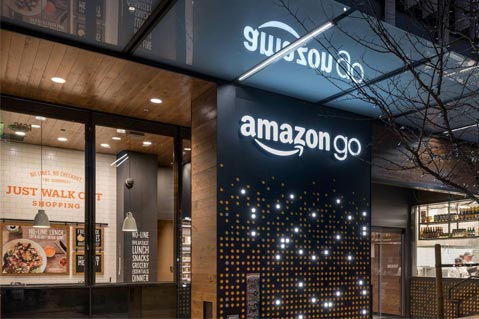December 08, 2016
Amazon Unveils Plan for Checkout-Free Grocery Shopping
Amazon announced this week that it plans to open checkout-free convenience stores. Dubbed Amazon Go, the corner stores will not have registers, so shoppers will be able to scan into the store using the Amazon Go app, pick out items from the shelves and leave the store with the selected products automatically billed to the customer’s Amazon account. Computer vision throughout the store means any item picked up will be automatically added to the shopper’s virtual cart, without the need for individual scanning.

In its official launch video for Amazon Go, Amazon says that computer vision, deep learning algorithms and sensor fusion, the same technologies used to power self-driving cars, make what it calls “Just Walk Out” technology possible. It’s an effort that’s been in the making for four years, according to the video.
Currently, an 1,800-square-foot store in Seattle, stocked with both perishable groceries and pre-made snacks and meals, is open to Amazon employees for beta testing purposes. It will be open to the public next year.
Increasingly frictionless transactions have been a focus of Amazon’s for several years. AmazonFresh, a grocery delivery service, is available in multiple metropolitan areas in the U.S. Earlier this year, the e-commerce giant announced that it would use drones for deliveries in 2017 and also launched a series of pop-up retail shops. The Amazon Dash Button for instant purchasing of household items was introduced two years ago.
While retail stores have long been tracking customers for targeting, upselling and determining both purchasing trends and optimal store layouts, linking specific products to individuals is largely a new frontier, according to Brent Franson, CEO of Euclid Analytics.
“Solving the problem of attaching the products to the person as they leave the store is going to require something new – or something we’re not aware of today,” he told Wired this week. “Tying the two together at 100 percent accuracy, that’s a problem that’s hard to solve.” He added that if the technology is not completely correct, customers will be able to take items free of charge, or will be charged for something they didn’t want to purchase.
Other shopping complications to be addressed include items returned to the wrong shelf, pricing by weight and a consolidated shopping cart for multiple people shopping together, Arun Nair, CTO and co-founder of RetailNext, told Wired, who added that “the technology building blocks are there.”
At potential risk are the jobs of grocery store cashiers. According to the Bureau of Labor Statistics, there were 856,850 cashiers on groceries’ payrolls in May 2015, the most recent data available. “It’ll be a big job-killer,” Britt Beamer, president of America’s Research Group, a consumer-behavior research and consulting firm, told the New York Post this week. “It’ll eliminate the cashier, it’ll get rid of the baggers, it’ll eliminate the stock clerks. This could be big.”
